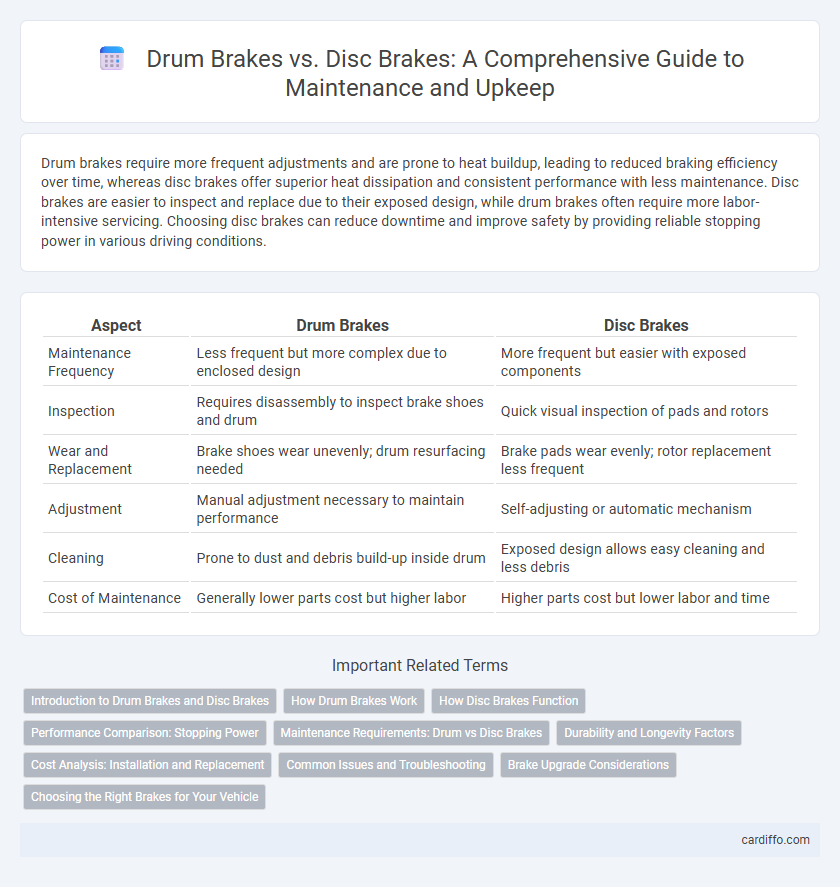Drum brakes require more frequent adjustments and are prone to heat buildup, leading to reduced braking efficiency over time, whereas disc brakes offer superior heat dissipation and consistent performance with less maintenance. Disc brakes are easier to inspect and replace due to their exposed design, while drum brakes often require more labor-intensive servicing. Choosing disc brakes can reduce downtime and improve safety by providing reliable stopping power in various driving conditions.
Table of Comparison
| Aspect | Drum Brakes | Disc Brakes |
|---|---|---|
| Maintenance Frequency | Less frequent but more complex due to enclosed design | More frequent but easier with exposed components |
| Inspection | Requires disassembly to inspect brake shoes and drum | Quick visual inspection of pads and rotors |
| Wear and Replacement | Brake shoes wear unevenly; drum resurfacing needed | Brake pads wear evenly; rotor replacement less frequent |
| Adjustment | Manual adjustment necessary to maintain performance | Self-adjusting or automatic mechanism |
| Cleaning | Prone to dust and debris build-up inside drum | Exposed design allows easy cleaning and less debris |
| Cost of Maintenance | Generally lower parts cost but higher labor | Higher parts cost but lower labor and time |
Introduction to Drum Brakes and Disc Brakes
Drum brakes feature a set of brake shoes inside a drum that rotates with the wheel, creating friction to slow the vehicle. Disc brakes use a caliper to squeeze brake pads against a rotor for efficient stopping power and heat dissipation. Both systems require regular inspection and maintenance to ensure optimal performance and safety.
How Drum Brakes Work
Drum brakes operate by pressing brake shoes outward against a rotating drum attached to the wheel, creating friction that slows the vehicle. The brake shoes retract when the pressure is released, allowing smooth wheel rotation. This system relies on hydraulic pressure to expand the shoes inside the drum for effective braking performance.
How Disc Brakes Function
Disc brakes function by using calipers to squeeze brake pads against a rotating disc or rotor attached to the wheel, creating friction that slows down or stops the vehicle. The hydraulic system transmits force from the brake pedal to the calipers, ensuring consistent and efficient braking performance. This design allows for better heat dissipation and improved stopping power compared to drum brakes.
Performance Comparison: Stopping Power
Disc brakes provide superior stopping power compared to drum brakes due to their efficient heat dissipation and consistent friction application under various conditions. Drum brakes tend to fade more quickly during prolonged or heavy braking because heat buildup reduces their effectiveness. Performance tests show disc brakes achieve shorter stopping distances and better responsiveness, especially in wet or high-speed scenarios, making them the preferred choice for safety-critical applications.
Maintenance Requirements: Drum vs Disc Brakes
Drum brakes require more frequent adjustments and inspections due to their enclosed design, which makes wear and contamination harder to detect. Disc brakes offer easier maintenance with simpler pad replacement and better heat dissipation, reducing the risk of brake fade. Overall, disc brakes tend to have lower ongoing maintenance costs and improved reliability compared to drum brakes.
Durability and Longevity Factors
Drum brakes generally offer longer lifespan due to their enclosed design, which protects components from dirt and debris, resulting in slower wear rates. Disc brakes, while more exposed, benefit from superior heat dissipation, reducing brake fade and maintaining consistent performance under heavy use. Durability in drum brakes is enhanced by thicker friction material, whereas disc brakes require more frequent pad replacement but often last longer in high-temperature environments.
Cost Analysis: Installation and Replacement
Drum brakes typically incur lower initial installation costs due to simpler components and widespread availability, making them a budget-friendly option for many vehicles. However, replacement parts for drum brakes, such as shoes and drums, tend to wear out faster and may require more frequent servicing, increasing long-term maintenance expenses. Disc brakes, while usually more expensive to install initially, offer longer-lasting pads and rotors, resulting in reduced replacement frequency and potentially lower overall ownership costs.
Common Issues and Troubleshooting
Drum brakes often suffer from issues like brake fade, uneven wear, and contamination from dust or moisture, which can cause reduced braking efficiency and noise; troubleshooting typically involves inspecting brake shoes for wear, cleaning components, and adjusting the brake mechanism. Disc brakes commonly experience problems such as rotor warping, caliper sticking, and pad glazing, leading to vibrations, reduced stopping power, and squealing sounds; maintenance requires checking rotor thickness, cleaning calipers, and replacing worn pads promptly. Regular inspection and timely replacement of worn parts are essential for both brake types to ensure optimal performance and safety.
Brake Upgrade Considerations
When upgrading from drum brakes to disc brakes, consider factors such as improved heat dissipation, which reduces brake fade during heavy use, and enhanced stopping power for increased safety. Disc brakes typically require less frequent maintenance and offer better performance in wet conditions, making them ideal for high-demand driving environments. Evaluate compatibility with your vehicle's braking system and budget to ensure a seamless and cost-effective upgrade.
Choosing the Right Brakes for Your Vehicle
Selecting the right brakes for your vehicle requires understanding the performance and maintenance differences between drum brakes and disc brakes. Disc brakes offer superior stopping power and heat dissipation, making them ideal for high-performance or heavy-duty vehicles, while drum brakes provide better durability and lower replacement costs, often suited for rear wheels or lighter vehicles. Evaluating driving conditions, vehicle type, and maintenance frequency ensures optimal brake system performance and safety.
Drum Brakes vs Disc Brakes Infographic

 cardiffo.com
cardiffo.com